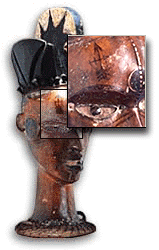
|
| Nsibidi Signs on Masks
Nsibidi signs are also found on some animal skin-covered masks, such as this one. Can you see the nsibidi sign on the forehead above the mask's right eye? |
 |
 |
 |
 |
 |
 |
© Michael C. Carlos Museum of Emory University,
Memorial Art Gallery of the University of Rochester and Dallas Museum of Art
For more information please contact odyssey@emory.edu.
Last Update:
